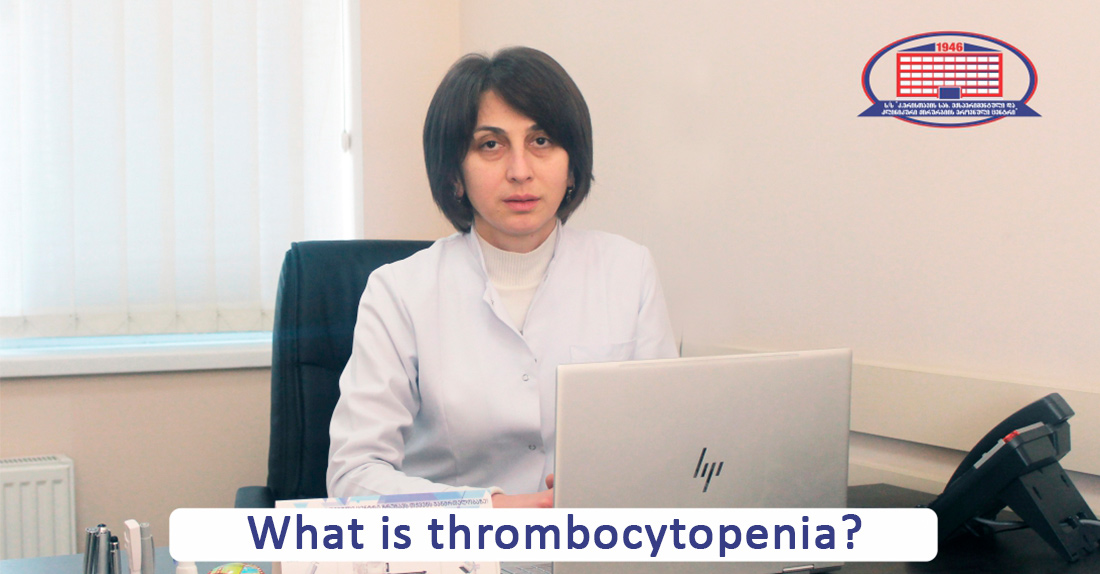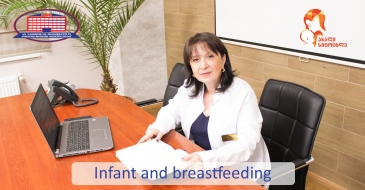
Platelets play an important role in the body.
In the interview, you will be informed about the following:
- Symptoms of thrombocytopenia;
- Causes and contributing factors of the disease;
- Diagnostics and treatment.
Platelet is a small cell and one of the primary elements in the clotting system preventing massive blood loss. It has a life span of 10 days and subsequently, is constantly produced in the bone marrow.
It’s worth mentioning that thrombocytopenia isn’t a disease, but a pathological condition when isolated platelet count in peripheral blood is lower than 100*109 /L and is or isn't accompanied by the hemorrhagic syndrome.
The disease is idiopathic thrombocytopenic purpura that will be discussed below.
Hematologist of National Center of Surgery, Doctor of Medicine Ekaterine Gaprindashvili discusses the topic.
– What are the symptoms of thrombocytopenia?
– It presents with the hemorrhagic syndrome,i.e. hemorrhage that might be spontaneous or post-traumatic. A patient has bruises on the skin and mucosal hemorrhage (petechiae and ecchymosis, nosebleed and bleeding gum) depending on the grade of thrombocytopenia.
Facial skin and mucosal hemorrhage are particularly dangerous – those symptoms indicate the expected emergence of petechial (spot-like hemorrhage) rash on the meninges. Uterine, gastrointestinal bleeding (melena in medical terms) and hematuria (blood in urine) are less common and commonly, emerge in severe thrombocytopenia. Prolonged bleeding after an injury should is also a red flag.
Immediately seek a hematologist at the emergence of any symptoms of the pathology.
– What causes thrombocytopenia?
–Pathology in all cases is caused by disbalance between production and breakdown pace of platelets. This is a condition when the bone marrow produces insufficient amount or their count decreases in circulating blood.
It’s worth mentioning that in some cases insufficient production of platelets in the bone marrow and increased breakdown in circulating blood occur simultaneously.
In most cases, decreased production of platelet is related to bone marrow injury or metaplasia (degeneration), also osteomyelofibrosis that leads to decrease in megakaryocytes (large bone marrow cell) count; it occurs in following diseases and conditions:
- Aplastic anemia (when the body cannot produce a sufficient amount of new blood cells);
- Myelodysplasia (a group of diseases in which blood cells are poorly formed and don’t function properly);
- Leukemia and multiple myeloma;
- Radiation and toxic effect on the circulatory system.
Thrombocytopenia of disseminated intravascular coagulation (DIC) syndrome and deposition (in hepatolytic syndrome, portal cirrhosis of the liver, Budd-Chiari syndrome), also some cardiovascular anomalies and diseases (aneurysm, disorders, stenting) progresses with increased platelet destruction.
It’s worth mentioning that immune thrombocytopenia, when increased platelet destruction is related to the damage of the immune system, is the most common. Primary immune thrombocytopenia (idiopathic thrombocytopenic purpura) belongs to the said group. It’s a disease when produced antibodies are directed towards platelet due to the damage of the immune system.
Secondary immune develops when the immune complex emerges in other autoimmune diseases (systemic lupus erythematosus, antiphospholipid syndrome, lymphoproliferative diseases), also in non-autoimmune diseases (gestational thrombocytopenia, infectious diseases, viral infections including the chronic type).
Contributing factors are as follows:
- Infections (particularly, viral ones);
- Pregnancy;
- Surgical intervention;
- Intense physical stress;
- Vaccination.
–What can you tell us about diagnostics and treatment methods?
– Comprehensive studies are necessary for diagnostics.
A complete peripheral blood count is the first one to be conducted; the isolated platelet count should be less than 100 * 109L in two or more analysis. It’s worth mentioning that this study is thoroughly conducted at our clinic because, alongside the device (analyzer), doctor-hematologist also reads complete peripheral blood count.
High level, thorough bone marrow studies are conducted at the clinic:
- Cytology studies that are necessary to rule out thrombocytopenia in acute leukemia, myelodysplasia, aplastic anemia, and other systemic blood diseases;
- Histology studies (trepanobiopsy) that are indicated if secondary thrombocytopenia is suspected.
The comprehensive metabolic panel is necessary to identify somatic diseases, immunoglobulin test to rule out immunodeficiency, viral studies to diagnose viral diseases that cause thrombocytopenia, coagulogram to evaluate plasma clotting factors.
Antiphospholipid, antithyroid, antinuclear antibodies test is a potentially informative study to rule out antiphospholipid syndrome, autoimmune thyroiditis, systemic lupus erythematosus.
A pregnancy test is also conducted.
The primary aim of the treatment is a resolution (alleviation, treatment) of hemorrhagic syndrome and not platelet count increase to its’ norm, whereas no less than 50*10 9/L without manifestation of hemorrhagic syndrome is considered a safe level.
Spontaneous bleeding in the above-mentioned level is caused by the following: vascular pathologies (vascular permeability, thrombocytopenia (a functional disorder of platelet), coagulopathy (a functional disorder of blood clotting system), etc.
10*10 9/L is considered a critical level for the development of life-threatening hemorrhages (uterine and gastrointestinal bleeding, blood in the urine or incessant nose bleed). Patients with this level of platelet, require emergency medical care.
In the case of 30–50*10 9/L treatment should be received if there’s a hemorrhagic syndrome.
Treatment of primary immune thrombocytopenia (idiopathic thrombocytopenic purpura) comprises immunosuppression and thrombopoiesis stimulation, whereas the management of secondary one is conducted based on the causing disease.
Emergency treatment methods are:
- Pulse-therapy (loading therapy with a high dose of corticosteroids);
- Immunosuppression with standard dosage;
- Splenectomy (spleen removal) when conservative treatment method isn’t effective;
- Platelet transfusion when bleeding fails to stop.
Wish you health!
What are patients interested in
Low hemoglobin count
Qauestion:: My father is 72 years old and has a hemoglobin level – 63, I’m interested in how low and dangerous is this level?
Splenomegaly
Qauestion:: Hello, as a result of the strike, my left side i.e spleen started to hurt several months ago. It can be identified through contact and it hurts. Then the pain was relieved but started to hurt again a few days ago. Spleen is enlarged. What can be the cause of it? It started to hurt again after I caught a cold. It could be examined through contact. How can the spleen return to its normal size and what can I take?







